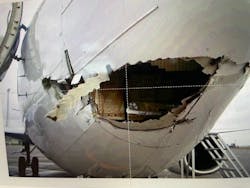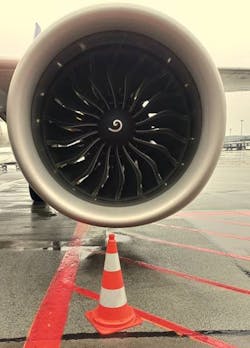Break the Ground Damage Code
Ground damage is a well-known problem in the aviation industry. The problem has existed since the start of aviation. During the last years (before the coronavirus pandemic), there has been a lot of focus on exactly this subject.
The cost often involves a loss directly on the bottom line. Many initiatives have been taken to come up with solutions in order to prevent these occurrences.
But up until now, the situation has not changed significantly, despite the many efforts and as so, safety is still a very important issue.
Definitions
Various organizations in the aviation industry have tried to come to an agreement on a common definition of how ground damage should be registered and not least associated to disruption cost. One is the definition of where the damage happens and the best one can be defined as follows. “Aircraft ground operation can be defined as from the moment the aircraft start taxiing, after landing run and until the throttles are commenced for take-off.”
A further detail is when breaking down into what exactly is included in damage of ground operation:
- Servicing, which includes all handling activities
- Maintenance
- Aircraft operation under its own power
- External actions e.g., airport authorities
Another question is what should be reported. In general, all damage should be reported when it happens and should be assessed by qualified maintenance staff before new departure.
However, unfortunately the most common damage is seldom reported when it happens and as so becomes classified as, “unreported damage.”
This will present a major problem if the damage has a bearing on the flight characteristic. Most damage happens by service equipment during handling. Exposed places include cargo doors, surroundings and wing-mounted engines.
Statistics
Statistics are often calculated in different ways and can therefore be difficult to compare.
Also, the definition of a “ground damage” is different depending on the airline or organization. Many organizations within the aviation industry have tried to create a common formula for measurement.
The International Air Transport Association (IATA) has been in the lead. Airports Council International (ACI) and Flight Safety Foundation (FSF) by their ground accident prevention (GAP) project have also tried. The calculation is based on the number of departures verses the number of registered as damaged, including unreported damage. On a worldwide basis, there were approximately 32 million departures with jet aircraft in service (in 2019), up from approximately 18 million departures (2001).
The damage frequency is normally calculated per 1,000 departures. Over the last 20 years, the damage frequencies have been on an average of 0.6-0.75 per 1,000 departures – some years higher and some years lower.
Based on the figures above, the total number can be calculated as, per 2019, 32 million departures multiplied by 0.7 per 1,000 departures equaling 22,400 damages per year worldwide.
But it should be noted that the magnitude of the damage ranges from a scratch that needs repair to a total loss due to ground damage.
Cost of Damage
The cost of ground damage has always been a subject of discussion.
Depending on the organization within each company, the way cost is calculated can vary.
Also, depending on where in the world it occurred, the cost can vary a lot due to the country’s economic standing. For example, the Nordic countries have a higher cost level than east Asian countries do.
If we use the Nordic countries cost level, an average damage’s direct cost has been calculated to approximately $18,000 (USD) per damage and the indirect cost (consequential/disruption) 4-10 times higher.
If we assume that six times higher is an average, the cost will be $18,000 multiplied by 6 multiplied by 22,400 equates to $2,419,200,000 (USD) – or the same as 30 new 737s or A320s.
It should be noted, that in this calculation personal injuries of staff is not included. The cost for passenger injury is marginal and also not included.
The indirect cost is the most difficult to calculate. The immediate indirect cost is obvious, but the longer the incident disrupts the operation, the more difficult it becomes to calculate.
The cost of disruption affects the airport, where the damage happened, and the disruption can impact a number of connecting flights as well.
Normally, the airlines have to take all the disruption cost, unless the agreement includes a specific liability to cover disruption cost caused by a third party.
Recently, disruption cost has increased due to the EU 261 passenger protection article.
A delay of more than X-number hours can be compensated. The compensation is depending on delay time and destination of flight, as a longer flight gets more compensation. Until now the airline would have to pay, even if it is a contracted party that is responsible. If the airline wants to be covered for this type of cost, they should have it incorporated in the contract agreement (in practice IATA Standard Ground Handling Contract) or a special insurance clause.
Examples of Ground Damage
A 737 needed maintenance on the engines, which required start up and test of the engines. Unfortunately, the maintenance created a delay of the flight schedule. During towing to the departure gate, the flight deck operator started the engine and applied more thrust to one of the engines (for test of the bleed system). The towing was straight forward and suddenly the aircraft took over control resulting in a jack-knife situation. The result was severe damage to the radome and the RH engine nose cowl.
Estimated repair cost amounted to $600,000 (USD) plus the aircraft out of service cost was not included. The incident could easily have been avoided by following the procedure and accepting a relatively small delay. The insurance will normally cover the repair cost above the deductible of $500,000 / $750,000 (USD).
In another example, an aircraft had a normal catering handling at the RH forward service door. The catering truck was a standard box type. The operation lever for up and down operation with the box has had a period failure but was not corrected. When the operator was in an up transition with the box, the control button would not stop from moving in the upwards direction. Before the emergency button was activated, the entire aircraft was lifted until the hinge broke and the door had severe damage. The direct estimated repair cost was $275,000. The failed operation lever could have been replaced for $25 (USD).
Preventive Actions to Reduce Ground Damage
Normally the reason for most ground damage involves a human being in one way or another. Therefore, focus should be in that direction, especially following the COVID-19 pandemic.
Many ground service personnel were laid off at the beginning of the pandemic. Now, one to two years later, many have been called back. That means, that routine and procedures should be refreshed, as many things have been changed.
In general, a few important steps are recommended before and upon employment:
- Effective screening of staff and background
- Basic training
- Recurrent training
- Feedback
- Team orientation
- Incentives / rewards
- Company culture knowledge
During the years, many examples of preventive actions have been implemented, some with success and some with less success. One of the more successful was the extended use of tip cones. In the mid ‘90s there were a lot of commercial low wing aircraft in operation and quite a lot of collisions between wings and trucks. Each collision had a cost of $75,000-$150,000 (USD).
Via the IATA Airside Committee, it was suggested and implemented as a standard to use tip cones to prevent wing damage. After some initial problems in introducing the procedure, it became normal to use them worldwide. Statistics from one airline operating a high number of lower wing aircraft showed, that after years using the cones, this particular damage was lowered 60 percent.
The tip cones are also used in front of aircraft with wing mounted engines. This has also had a significant impact on the number of lip nose cowl damage.
The Next Step for Breaking the Ground Damage Code
There is a continues development of equipment and procedures in order to reduce ground damage. For example, IATA’s Safety Audit for Ground Operations (ISAGO) and the IATA Ground Operations Manual (IGOM) implementation has not had an impact enough to break the ground damage code so as to reduce the number of incidents significantly.
Another way is to step up the investigations of an incident to find the root cause. Very often ground damage investigation is concentrated to those directly in “contact” with the aircraft.
Another new approach in order to prevent ground damage, is the development of driverless ground equipment. The new equipment will soon be tested in operation and could prove a code breaker for ground damage. Time will tell.
Finally, to be directly economically accountable for damage and disruption, a preventive method would be best. But several attempts to modernize contracts and agreement in that direction have not been able to do this so far.


